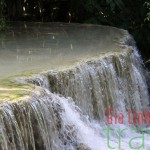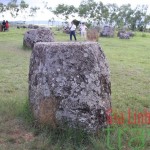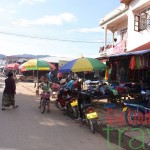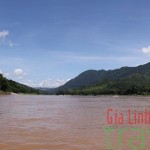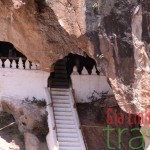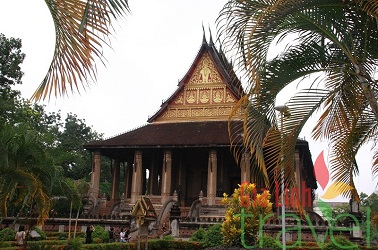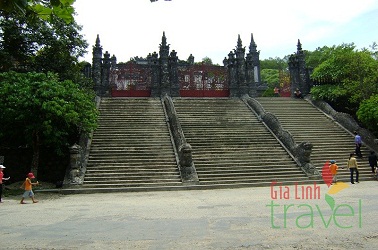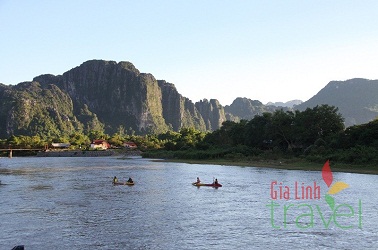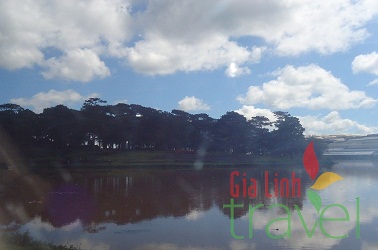Incredible Charm of Laos – 10 days
UNESCO has recognized and preserved a former capital of the realm Luang Prabang, also known as the “Kingdom of Millions of Elephants” in the 13th century. This tour takes you to visit historical relics including a trip to the ruins of the Khmer temple Wat Phou near Pakse, the mysterious plain of jars in Xiengkhouang and the ancient remnants at Don Khone Island. You will also absorb the hidden sleeping beauty within the 4000-island region, and be captivated at the sight of Southeast Asia’s largest waterfall, Khone Phapeng
PROGRAMME IN DETAILS FOR INCREDIBLE CHARM OF LAOS 10 DAYS
Destinations: Luang Prabang/Xiengkhouang/Vientiane/Pakse/Don Khone Island/Tadlo
B = Breakfast, L = Lunch, D = Dinner, G = Guide
Day 1: Arrival at Luang Prabang (D, G)
Upon arrival at the airport, you will be met and transferred to your hotel. Luang Prabang is perhaps the best-preserved traditional city in Southeast Asia. The tranquility and charm of this town with its splendid natural scenery and cultural sights make it one of the most delightful places to visit in Laos. After a short rest, you’ll visit the impressive stupa of Wat Visoun and the shrines of Wat Aham and Wat Mai. You’ll then climb up to the top of Mount Phousi for an enjoyable exploration of the sacred, gilded stupa as you’ll enjoy a beautiful sunset view of the city and the Mekong River. From there, you’ll explore the Night Market, where you can find a lovely selection of handmade textiles made by the local and hilltribe people surrounding Luang Prabang. Overnight in Luang Prabang.
Day 2: Luang Prabang/Pak Ou Caves/Luang Prabang (B, L, G)
After breakfast, you’ll enjoy a short-guided tour seeing the city’s oldest temple Wat Sene and the magnificent Wat Xiengthong with its roofs syou’lleping low to the ground, representing classical Laotian architecture. You’ll then board a cruise upstream on the Mekong River, which gives us a panoramic view of the tranquil countryside as you’llll as an interesting visit to the mysterious Pak Ou Caves, two linked caves crammed with thousands of gold lacquered Buddha statues of various shapes and sizes left by pilgrims. En route, you’ll stop at the village of Ban Xanghai, where the local speciality of rice wine is produced. Once back in Luang Prabang city you’ll take a short drive to Ban Phanom, a village well-known for its hand weaving. You’ll also have time to visit Ban Xangkhong and Ban Xienglek, small villages you’llknown for silk you’llavings and for Saa (jute) Papermaking Overnight in Luang Prabang.
Day 3: Luang Prabang/Khouangsi Waterfalls (B, L, G)
An optional early start gives you the fantastic opportunity to participate in the daily morning rituals of saffron-clad monks collecting offerings of Alms (often in the form of sticky rice) from the faithful residents. This tradition is very unique in Laos, being the only Buddhist nation still preserving the ritual. You can also visit the morning Phosi Market where you canl see such diverse offerings as dried buffalo skin, local tea and saltpeter among the chickens, vegetables and hill-tribe you’llavings. Laos is also known for its traditional handicrafts, and today you will visit local village of Lao ethnic minority groups at Ban Ouay and Ban Thapene. Time permitting you may also wish to drive to the beautiful Khouangsi Waterfall where you can take a dip in the inviting pools or walk along the forest paths. You’ll return to Luang Prabang by late afternoon and continue to Ban Phanom, a well-known weaving village, and then return to the city by late evening to admire the sunset at Wat Siphouthabath. Overnight in Luang Prabang.
Day 4: Luang Prabang/Xiengkhouang (Road) (B, L, G)
After breakfast, you’ll visit the National Museum (close Tuesday) at the former Royal Palace, which displays a lovely collection of artefacts reflecting the richness of Lao culture dating from the days of the early kings right through the last sovereign. Today, you’ll drive 306km uphill a mountain surrounded by wonderful natural scenery to Xiengkhouang. Upon arrival, you’ll be transferred to visit the Plain of Jars, an impressive archaeological site where hundreds of large stone jars are scattered all over the plateau. If time permits, you’ll see the old capital of Muang Khoun and the nearby villages, home to the Hmong hill tribe people. They have an interesting local culture and a colorful history. Overnight in Phonsavanh (B)
Day 5: Xiengkhouang/Vientiane (Flight) (B, G)
Following breakfast, you’ll visit the Central Market. Afterwards, you will have free time to explore the town further before catching our flight back to Vientiane. After checking into the hotel, time permiting you’ll continue our sightseeing tour of the surrounding areas of Vientiane; you’ll visit the impressive Lao-Thai Friendship Bridge and Buddha Park, an enchanting collection of Buddhist and Hindu sculptures on the Mekong Riverside meadow, close to the Friendship Bridge. There are approximately 200 religious images dating back over 500 years, which were created by a mysterious monk spreading his philosophy on life and revealing his ideas about the universe. A spectacular view of the Mekong River at sunset is a perfect way to finish the day. Overnight in Vientiane.
Day 6: Vientiane City Tour (B, L, G)
After breakfast, you’ll continue to explore Vientiane capital by visiting the major sights of the capital; including the oldest Wat Sisaket with thousands of miniature Buddha statues and the former royal temple of Wat Prakeo, which previously housed the famous Emerald Buddha Image. Enroute to Lao’s national precious heritage, the famous and sacred structure of That Luang Stupa, you will have the opportunity to take some pictures of the imposing Patuxay Monument, which is well-known as Vientiane’s own Arc de Triumph.
In the afternoon, you’ll continue visiting the rest of Vientiane by foot, including Wat Ong Tue, Wat Inpeng and Wat Haisok. You’ll pass by the major shopping area continuing to the Vientiane Central Market of Talad Sao and Talad Kouadin where various goods are displayed for sale; including fresh food, household goods, souvenirs, textiles, gold, silver and antiques. You’ll return to the Mekong Riverside in the late afternoon for observing the sunset. Overnight in Vientiane.
Day 7: Vientiane/Pakse/Don Khone Island (Flight) (B, L, G)
After breakfast, you’ll catch an early flight to Pakse. On arrival, you’ll drive south to Champassak and tvisit the fascinating pre-angkorian ruins of Wat Phu, one of Southeast Asia’s most dramatically situated temples. You’ll have time to explore these intriguing Khmer ruins, which are perched at the base of Mount Phu Kao. You’ll continue your journey by long tail boat to Don Khone, the largest island in the South Mekong river region known as the 4000 islands, one of the most scenic areas in Laos. Overnight on Don Khone Island.
Day 8: Don Khone Island’s Surrounding (Boat) (B, L, G)
After an early morning breakfast, you’ll begin by re-tracing the French colonial-past at Ban Khone, where some old colonial houses still stand and glimpse the first Lao railway with its own locomotive. You’ll continue our exploration of the area of the 4000 islands leisurely by boat and visit the most beautiful Liphi waterfall, also known as the Samphamith, which forms a natural border betyou’llen Lao and Cambodia. If you’ll have luck, you’ll may catch a glimpse of the rare freshwater Irrawaddy Mekong dolphin at Ban Hang Khone. You’ll return to Ban Nakasang and drive to the famous waterfall of Khone Phapeng – the largest waterfall in South East Asia, also known as the ‘Niagara of the east’. Overnight on Don Khone Island.
Day 9: Don Khone Island/Tadlo/Pakse (B, L, G)
Upon leaving Done Khone Island, you’ll journey towards Tadlo, through the Boloven plateau. The Boloven Plateau is known for its cooler temperature being located high above the Mekong Valley. Rivers run off this high plateau in all directions and then plunge out to lush forests along in a series of spectacular surging waterfalls. A trip to the plateau provides a refreshing break from the heat and allows you to observe the cultivation of rich coffee, tea, cardamom, bananas, and other crops that can be seen en route. This trip gives visitors the chance to venture off the beaten track and to discover some of the lesser-known areas of Laos, exploring the wild beauty of this southern region. Upon arrival at Tad Lo waterfall, you’ll visit the villages of Alak, Nge, and Katu, populated by ethnic minority groups. You’ll return to Pakse by late evening. Overnight in Pakse.
Day 10: Pakse Departure (B, G)
After breakfast, there will be free time for your own exploration of Pakse Town before catching a flight to Siem Reap (Cambodia) or exiting Laos overland from the Chongmek International checkpoint to Ubon Ratchathani Thailand.
Price in US$ per person:
Our price includes:
- Breakfast and accommodation sharing a twin or double room.
- Pick-ups and transfers by private air-conditioned vehicle as specified in the itinerary above
- Travel by private, air-conditioned vehicle with an experienced, safe driver.
- One way domestic flight tickets: Xiengkhouang – Vientiane , Vientiane – Pakse including domestic airport taxes.
- Boats cruise as programme.
- The services of experienced English-speaking guides as indicated in the itinerary
- Where necessary, entry fees for all visits as mentioned in the programme.
- Lunches and dinners, as specified, in the good local restaurants, picnics where suitable restaurants are not available.
- VAT and other taxes
Our price does not include:
- International flight tickets and airport tax.
- Visa stamping fee on arrival US$30.00/pax
- Dinners, except as specified above.
- Drinks, gratuities and personal expenses.
- Insurance.
Hotel list for Two-Stars standard:
- Luang Prabang: Sanakeo hotel (** located in the city centre) or similar
- Xiengkhouang: Banna House (good local standard) or similar
- Vientiane: Asian Pavilion Hotel (** located in the centre of Vientiane) or similar
- Khone Island: Sala Done Khone Hotel (** situates on the Mekong River and right in the heart of Ban Khone village) or similar
- Pakse: Pakse Hotel (** once the first big building constructed under the supervision of Jao Boon Oum, last King of Southern Lao; located in the centre of Pakse, within walking distance from the Mekong River) or similar
Hotel list for Three-Stars standard:
- Luang Prabang: Sala Prabang Hotel (*** on the banks of the Mekong River and consists of well restored small colonial houses) or similar
- Xiengkhouang: Phou Phadeng Auburge Hotel (** perched high on a peaceful hillside) or similar
- Vientiane: Inter City Hotel (*** beautifully decorated with antiques and artifacts; located in the heart of the city) or similar
- Khone Island: Sala Done Khone Hotel (** situates on the Mekong River and right in the heart of Ban Khone village) or similar
- Pakse: Pakse Hotel (** once the first big building constructed under the supervision of Jao Boon Oum, last King of Southern Lao; located in the centre of Pakse, within walking distance from the Mekong River) or similar
Hotel list for Four-Stars standard:
- Luang Prabang: Villa Santi Hotel (**** located in the heart of the World Heritage Site with walking distance to many historical sight seeing places) or similar
- Xiengkhouang: Vansana Plain of Jars Hotel (*** perched high on a peaceful hillside) or similar
- Vientiane: Novotel Hotel (**** located close to both the centre of Vientiane and the airport) or similar
- Khone Island: Sala Phae Float (** carefully built with grass thatched roof, bamboo wall panelling and hardwood flooring, in perfect hamonization with the nature) or similar
- Pakse: Champasak Palace Hotel (*** elegantly located in the heart of Pakse; originally constructed to be a palace of Jao Boon Oum, the last king of life (Jao Ma Ha Chee Vit) in southern Laos) or similar
Hotel list for Five-Stars standard:
- Luang Prabang: La Résidence Phou Vao Hotel (***** a luxury spa hotel with breathtaking views of the mountains and surrounding World Heritage town of Luang Prabang) or similar
- Xiengkhouang: Vansana Plain of Jars Hotel (*** perched high on a peaceful hillside) or similar
- Vientiane: Settha Palace Hotel (***** located in the heart of bustling Vientiane, built in the early part of the last century, circa 1932, and painstakingly restored to its former imperial glory) or similar
- Khone Island: Sala Phae Float (** carefully built with grass thatched roof, bamboo wall panelling and hardwood flooring, in perfect hamonization with the nature) or similar
- Pakse: Champasak Palace Hotel (*** elegantly located in the heart of Pakse; originally constructed to be a palace of Jao Boon Oum, the last king of life (Jao Ma Ha Chee Vit) in southern Laos) or similar
